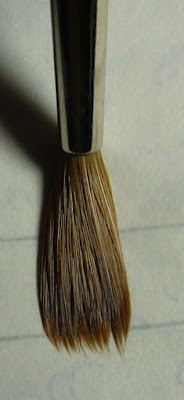
Well back after a long break - not on holiday unfortunately!
Today I want to talk a little bit about colour prejudice in watercolour painting and, like colour prejudice in the human population, it concerns the colours black and white. However, here the similarity ends thank goodness!
Traditional watercolour purists would never use black or white in their paintings, asserting that black is a 'dead' colour and that white in a watercolour should only be achieved by leaving virgin areas of paper.
When I started painting in the long distant past, being a very law-abiding person, I used to follow this rule and it frequenly made my life very difficult indeed. How do you have white whiskers on a dog for instance if you don't paint them in? Well, when I didn't use white, I basically had two options. One was to simply scratch the paint away with a sharp blade but although I tried many, many times, I never became very proficient at this and instead of nice clean, sharp lines, I used to end up with somewhat 'bobbly' lines. The other technique is to cover the paper you wish to reserve with masking fluid. Masking fluid is a whitish liquid which dries to a rubbery consistency which you can then peel off from your paper. If you decide to have a try with masking fluid, use a pen and not a brush as I did at first - you will never get the dried fluid off your brush. If you want to cover a larger area and have to use a brush, use an old one as you will need to throw it away afterwards. Speaking personally though, like the scratching technique, I never enjoyed using masking fluid.
In my own work, I use watercolour paint in many layers. This in itself would be frowned upon by purists. The fact that I use black and white would just confirm their worst opinion!
However, I must make a couple of, I believe, very important points. Firstly I never mix white with any other colour. I have a real distaste for something which is actually quite widespread in watercolour paintings, and that is 'chalkiness'. I find that this chalkiness completely deadens the painting and removes the light and life from it. I mostly use white where it is the final colour i.e. whiskers or hairs overlapping a coloured part of an animal's coat or the lighest part of a white section. Occasionally I will use it as a 'basecoat' in a small part of the painting. By this I mean that I will paint a very small area white, wait for it to dry completely and then very carefully and lightly, apply a dryish thin coat of colour over the white, thus allowing the white to shine through. If I make a mistake and apply the colour a little too wet or not quite lightly enough and it starts to mix with the white below, I will immediately add more water to dissolve the paint and mop it up - I really, really do hate chalky paintings! Unfortunately this technique is very time-consuming which is why I believe so few artists use it.
As for black I usually use lamp black and add just a little of another colour to enrich it - perhaps a touch of French ultramarine or burnt sienna. I recently bought some mars black but am being very careful about how I use it and in fact will only use it for backgrounds as I like the way it granulates. I dislike it in the body of the painting however as it is a dead, flat colour and despite being black has that 'chalkiness' about it that I don't want in my paintings.
I've included a painting of a border collie today - a black and white dog. This painting contains very little white paint indeed - just the whiskers and where some of the white hairs overlap the black. All the shine in the coat is the paper shining through the paint. Although, as I say, I use many layers of paint, I am careful in certain areas, to make these layers very thin and transparent so that the finished painting will be lively and fresh. The black has been moderated with touches of blue and brown.
So although I am not colour prejudiced in my paintings and will use both black and white, I use them with care.




























.jpg)
.jpg)

.jpg)